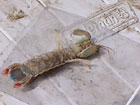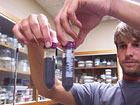

 | |||||||||||||||||
|
|
Journals 2005/2006Sarah Mitchell
July 7, 2005 Today was the first day at a new site, Parrot Creek, which was not far from the lab. Our job was to collect some water and benthic samples and deploy the sonde. The stretch of the creek we were sampling was best accessed by car. We could park near two different entry sites, and walk along the road to access the third. Collecting water samples it is important to start down stream, so as not to disturb water yet to be collected. We drove to the best access for the farthest sight and Ann and I volunteered to go down to get the sample. We walked to the marsh along a ditch running by a private home. The distance from dry land to the creek across the marsh wasn't too far, and walking was fairly easy until we reached the creek. I volunteered to go in to get the water. Following Anne's directions I faced up stream, inverted the bottle, and reached down about elbow depth. I collected some water, lifted it out, capped, shook and poured that water out behind me, so it would not contaminate my collection. This process is repeated and then a sample is taken. So far so good. I tossed the bottle to Anne who was standing up in the grassy area. Getting out of the creek was a challenge. With six foot tides here, the banks of the creeks are often quite steep as it was here. Additionally, the mud here offered no resistance, so as I tried to climb up, I sank down. It's amazing how muddy I got in such a short period of time. The drive to the next access point wasn't far, so Anne and I just rode in the back of the truck. The best place to park for our next site was in a church parking lot. We made our way along the property fence line where we ran into poison ivy. It's funny, when I first thought about coming down here I was most concerned with the bugs I'd face in the marsh. That has proven to not be an issue at all. On the other hand, fire ants, poison ivy and mosquitoes have all been found on the high and dry ground! The fence ended in the junkus, and we made our way to the border of it and the spartina. We had to walk a stretch down stream so we did so as high in the marsh as we could. Unlike all the other sites I have been to, this area is very developed. There were houses on either side of the creek, and each house had a long dock extending through the marsh into the creek. It would have physically been so much easier to ask if we could just come down the closest dock to our site, but the staff wouldn't think of it. Our collection site was not far from the end of one of these docks, so we made our way along the pilings. The closer we got to the bank, the more pluff mud we ran into and the deeper we sank in the muck. By the time we reached the creek bank, we were all on our knees making slow forward progress. We dropped off the sonde to be placed later, took some water samples and heading back to the truck. This let us drop the sample off in the cooler and then walk along the road to the bridge to access the point furthest upstream. From here we had to walk down stream to access the next several sites. At first the bottom of the creek was fairly firm, but as we approached the middle stretch, walking in the creek proved too difficult. The decision was made to head up into the marsh, and everyone took that turn from their current spot in the creek. Some sites proved firmer than others, but within about two steps I was on my knees, and that didn't last long either. I was sinking so deep, that pulling my leg forward required first scraping off some of the weighty mud. This helped, but made for very slow going. I don't know if it was my small feet, lack of experience or what, but I felt like I had on high heels and was diving into the mud with each step. When "knee walking" proved ineffective the next move was to disperse my weight more by laying down. After "swimming" for a few minutes and making little if any progress, one of the guys was able to stretch some wood to me which was enough to move myself to slightly firmer ground. I later learned that the last time they were at this creek, someone had to be rescued with the pole used for the sonde. Once back in the spartina, walking was easier thanks to a somewhat firmer ground. The heat, mud and physical effort were wearing me out. Again, my admiration for the people who go through this every day rose to a new level. I wondered why they chose to do it rather than farming it out to young and energetic undergraduates. The response was that the results were too important to risk not doing things properly. If someone didn't really understand the importance of the outcome, they might take short cuts which could jeopardize the data. What dedication. The last site was the same one we had left the sonde at earlier, and knowing how difficult moving there was and how exhausted I was, I chose not to go all the way into the creek here. As it turned out, this may have been a very wise decision. First of all, it allowed me a few quiet moments alone in the marsh. I wondered how many people have ever had the chance to experience this. While I was contemplating the serenity and wondering about the future of such sites, I became aware of a "popping" sound. I wondered what else there was to discover out there. The others had set the sonde out and were making their way back out of the creek. As they crawled through the mud near the creek bank, another interesting discovery was made. There was a creature in the mud, about 15cm long. It was later identified as a mantis shrimp. Though not really a shrimp or a mantis, it bears characteristics resembling each. It has a shrimp like, segmented abdomen and carapace, swimmerets and claw-like appendages. The resemblance to a preying mantis is in the positioning and use of these "claws".
Then it was back through the marsh, under the docks, along the fence and back to the truck. All our samples were put on ice and we all got some much needed water to drink. This was by far our muddiest day yet. We still had to drive around to access the final sites before heading back, and luckily we found a spigot outside the church so that Mark could get washed off enough to drive the truck. The rest of us just rode in the back.
Access to the final sites brought us back to our original spot. We parked the truck, grabbed our gear, and headed along the ditch to the marsh. We needed to access the creek at various spots for collections, and sometimes walking in the creek from site to site wasn't too bad. At others, it was back to crawling along on all fours or heading back up into the marsh. With all the samples collected and the sonde deployed, we made our way back to the truck. The gentleman who lived in the house next to the ditch was kind enough to let us rinse off with his hose. Oddly, he never asked what we were doing or why. Back at the lab after cleaning and processing everything from the day, I had a chance to watch Mark extract and analyze the pore water. This is done with the mud samples collected using the PVC pipe. First the samples are homogenized by squeezing the bags to mix the various samples from the different reaches. A small hole is cut in the corner and a sample is placed in a tube which is then spun in a centrifuge. This separates the pellet (sediment) from the supernatant (lighter liquid). The water is then drained off into smaller tubes and after a QAQC is run, tested for pH and ammonia content. The presence of ammonia indicates how much organic material is breaking down. In the field, the samples are placed on ice as soon as possible to slow down this process.
|
||||||||||||||||



